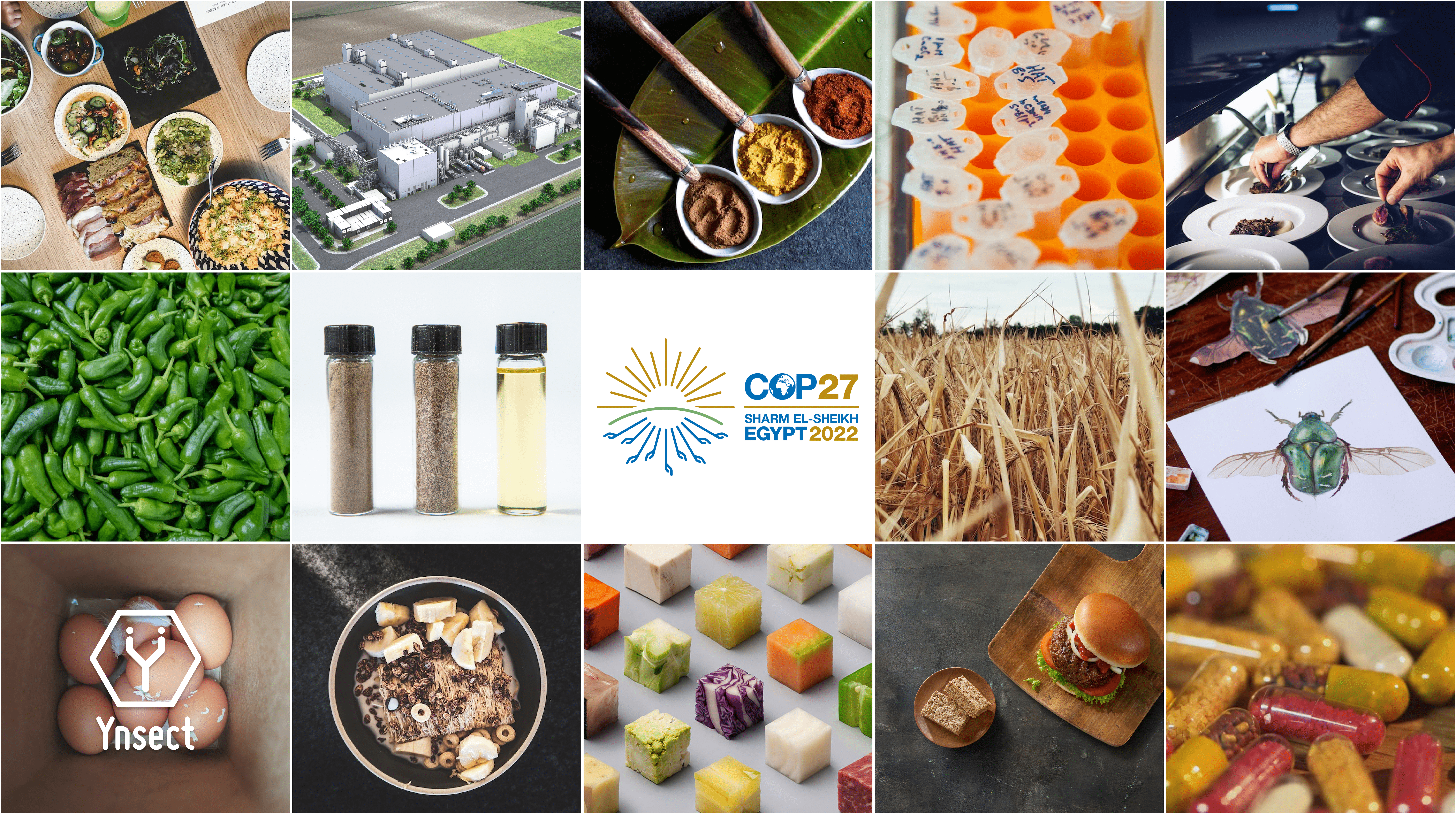COP27 marks the first time that food systems have been given a dedicated platform in the UN Climate Change Conference, highlighting the “huge opportunity” [1] that transforming our approach to diet and agriculture would represent for the environment. Indeed, a recent study has found that if we were to completely eliminate animal protein from our diet, we could reduce environmental impacts by 80% — and moreover, the optimal diet would include insect protein. It seems timely to take a closer look at the potential benefits of so-called “future foods”.
When Sandrine Rousseau, MP for the French greens party, recently called on her compatriots to reduce their “macho” red meat consumption in favour of a more plant-based diet, she caused something of an outcry in the land of saucisson and boeuf bourguignon. But there was nothing controversial in her claim that such a modification in our eating habits can help mitigate climate change — the most recent climate report from the IPCC points to “consistent evidence” [2] that dietary patterns favouring plant-source foods (PSF) over animal-source foods (ASF) are associated with lower environmental impact, both in terms of greenhouse gases and land and water use. Nevertheless, even PSF have their limitations: agriculture still requires land and water, albeit less than ASF; fertilisers and pesticides can introduce pollutants to the environment; and crops are vulnerable to extreme weather events such as storms, wildfires and droughts. Hence there is growing interest in diets based on a third option: so-called “future foods”, a topic that is gaining focus at COP27 for the first time.
“Future foods” increase food security
Future foods (FFs) are novel alternatives to animal and plant protein, which are equally nutritious while at the same time having a lower environmental impact, and additionally being less vulnerable to risk [7]. Various insect larvae are among the currently available FFs; others include microalgae (such as spirulina), macroalgae (kelp) and mussels, and mycoprotein (a super-protein from fungi — Quorn is the most well-known example on the market).
Typically, FFs draw on new technologies which allow them to be cultivated in closed environments with modular architectures — in the case of insect farming, nurseries are compartmentalised and stackable. This makes it possible to maintain consistent internal conditions, such as temperature and humidity, so that production is largely unaffected by climate variability. This in turn grants freedom from any particular geographical constraints, which also means that production centres can be located in or near urban areas, making the supply chain less vulnerable to trade blockages (such as we experienced during the Covid-19 pandemic and the war in Ukraine). Compartmentalisation reduces the risk of disease spreading, by confining any potential contamination to a single unit, as well as increasing system stability through operational redundancy, and making it easier to scale up (or down) production in response to changing demand.
Future foods can meet our nutritional needs
So these FFs are less susceptible to risk — but can they really supply everything we require, nutritionally? They have been selected because they are good alternative sources of protein, but do they also provide all the necessary vitamins and minerals? The short answer is yes — certainly, a mixture of FFs covers all bases [6]. In particular, mealworm larvae are an excellent source of zinc and are high in magnesium, and provide all essential amino acids [4]. They also meet our requirements for vitamin B12 and omega-3 fatty acids, which are conspicuously lacking in PSFs — so a diet including FFs such as mealworm larvae is actually a healthier option than a purely vegan diet.
Future foods have low environmental impact
In terms of land use, FFs have — unsurprisingly — considerably less impact than either ASFs or PSFs. Aquatic FFs require no land at all; and insect farming requires only minimal land use, because feed production is heavily supplemented by so-called “leftover streams” of recycled biomass. In terms of GHG emissions, however, while FFs perform better than most ASFs, they fall short of PSFs. This is because of the energy required by the novel technologies: in the case of insects, electricity is required to maintain the temperature and humidity of the rearing environment, and to dry the larvae. Nevertheless, in comparison to ASFs, insects have a higher reproduction rate and greater protein efficiency, shorter maturation period, lower energy investment; they also are completely edible, leaving no bio-waste such as bones, skin, feathers, etc.. All of this leads to insects having a much lower environmental impact than ASFs: for example, in a nutrient-for-nutrient comparison, a diet based on mealworms contributes twenty times less methane and fifty times less nitrous oxide to the atmosphere than a diet based on pork.
Insect FFs are a key part of optimal diets
When attempting to assess the relative benefits of different diets, how can environmental impact be weighed up against nutritional benefit? A recent study [5] has addressed this question through a comprehensive optimisation model. They first compiled nutritional data relating to 124 food products, across 18 food groups (including fruit, vegetables, meat, fish, dairy, and others), and identified the proportions of each of these food groups that comprise the current average European diet. They then ran the model to identify the proportions of each food group that, while still meeting all daily nutrient requirements, would minimise one of three environmental impacts: Global Warming Potential, Water Use, or Land Use. The results were eye-opening. In all cases, the optimal diet reduced the environmental impact in question by more than 80%, in comparison to the current average diet. In the first instance, FFs were excluded from the model diets; in this case, the optimal diet was essentially vegan, eliminating almost all meat, fish and animal fat. When the model diets were allowed to include FFs, the optimal diet was found to include FFs — specifically insect meal: this diet had lower impact on water and land use than a vegan diet without FFs. Finally — anticipating that many societies may be reluctant to completely remove ASFs from their dietary patterns — an “omnivore” diet was explored, that included a minimum quantity of animal products, with and without FFs. In all cases, the optimal diets in which FFs were included were significantly better for the environment than the corresponding diet without FFs — and again, insect meal was consistently part of the optimal diet.
The future is now
On the basis of all this, it seems fairly clear that the “best” diet for the environment and food system resilience — current topic focuses at COP27 — is essentially a vegan diet to which future foods have been added — and specifically, that insect meal is an important component of this optimal diet. Moreover, while some future foods have not yet undergone rigorous food safety tests, there are already six insect-based food products that have been approved by the EFSA [3] — making these insect products less of a “future food” and more of a readily available ingredient. So, while it may be unrealistic to imagine that Europeans will transform their eating habits overnight, it would seem that there is no obstacle to such a transformation; and given the potential environmental benefits, perhaps with the help of the topic shift at COP27, it is time to decide that the future is now.
References
1. https://foodsystemspavilion.com
2. https://www.ipcc.ch/srccl/chapter/chapter-5/
3. e.g. European Commission (2022) EFSA Journal 2022;20(7):7325. doi.org/10.2903/j.efsa.2022.7325
4. Grau et al. (2017). Z. Naturforsch 72(9). doi.org/10.1515/znc-2017–0033
5. Mazac et al. (2022) Nature Food 3: 286–293. doi.org/10.1038/s43016–022–00489–9
6. Parodi et al. (2018). Nature Sustainability 1: 782–789. doi.org/10.1038/s41893–018–0189–7
7. Tzachor et al. (2021) Nature Food 2:326–329. doi.org/10.1038/s43016–021–00269-x





